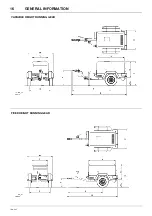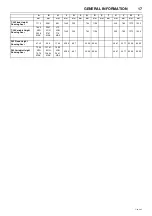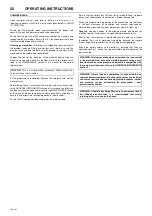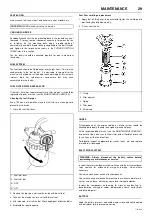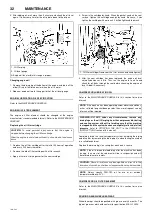
MAINTENANCE
27
7/20, P65
ROUTINE MAINTENANCE
This section refers to the various components which require periodic
maintenance and replacement.
The
MAINTENANCE SHEDULE
indicates the various components’
descriptions and the intervals when maintenance has to take place. Oil
capacities, etc., can be found in the
GENERAL INFORMATION
section
of this manual.
For any specification or specific requirement on service or preventative
maintenance for the engine, refer to the
Engine Manufacturer’s
Manual
.
Compressed air can be dangerous if incorrectly handled. Before doing
any work on the unit, ensure that all pressure is vented from the system
and that the machine cannot be started accidentally.
If the automatic blowdown fails to operate, then pressure must be
gradually relieved by operating the manual blowdown valve. Suitable
personal protective equipment should be worn.
Ensure that maintenance personnel are adequately trained, competent
and have read the Maintenance Manuals.
Prior to attempting any maintenance work, ensure that:-
•
all air pressure is fully discharged and isolated from the system. If
the automatic blowdown valve is used for this purpose, then allow
enough time for it to complete the operation.
•
the discharge pipe / manifold area is depressurised by opening the
discharge valve, whilst keeping clear of any airflow from it.
•
the machine cannot be started accidentally or otherwise, by posting
warning signs and/or fitting appropriate anti-start devices.
•
all residual electrical power sources (mains and battery) are
isolated.
Prior to opening or removing panels or covers to work inside a
machine, ensure that:-
•
anyone entering the machine is aware of the reduced level of
protection and the additional hazards, including hot surfaces and
intermittently moving parts.
•
the machine cannot be started accidentally or otherwise, by posting
warning signs and/or fitting appropriate anti-start devices.
Prior to attempting any maintenance work on a running machine,
ensure that:-
•
the work carried out is limited to only those tasks which require the
machine to run.
•
the work carried out with safety protection devices disabled or
removed is limited to only those tasks which require the machine to
be running with safety protection devices disabled or removed.
•
all hazards present are known (e.g. pressurised components,
electrically live components, removed panels, covers and guards,
extreme temperatures, inflow and outflow of air, intermittently
moving parts, safety valve discharge etc.).
•
appropriate personal protective equipment is worn.
•
loose clothing, jewelry, long hair etc. is made safe.
•
warning signs indicating that Maintenance Work is in Progress are
posted in a position that can be clearly seen.
Upon completion of maintenance tasks and prior to returning the
machine into service, ensure that:-
•
the machine is suitably tested.
•
all guards and safety protection devices are refitted.
•
all panels are replaced, canopy and doors closed.
•
hazardous materials are effectively contained and disposed of.
PROTECTIVE SHUTDOWN SYSTEM
Comprises:
•
Low engine oil pressure switch
•
High discharge air temperature switch
•
High engine coolant temperature switch
Low engine oil pressure switch.
At three month intervals, test the engine oil pressure switch circuit as
follows:
•
Start the machine.
•
Remove a wire from one terminal of the switch. The machine should
shutdown.
At twelve month intervals, test the engine oil pressure switch as
follows:-
•
Remove the switch from the machine.
•
Connect it to an independent low pressure supply (either air or oil).
•
The switch should operate at 0,83 bar (12 psi).
•
Refit the switch.
Temperature switch(es).
At three month intervals, test the temperature switch circuit(s) as
follows:
•
Start the machine.
•
Disconnect each switch in turn. The machine should shutdown.
•
Re-connect the switch.
High discharge air temperature switch(es).
At twelve month intervals, test the air discharge temperature switch(es)
by removing it from the machine and immersing in a bath of heated oil.
The switch should operate at 120°C (248°F.) Refit the switch.
High coolant temperature switch.
At twelve month intervals, test the coolant temperature switch by
removing it from the machine and immersing in a bath of heated oil.
The switch should operate at 115°C (239°F). Refit the switch.
SCAVENGE LINE
The scavenge line runs from the combined orifice/drop tube in the
separator tank, to the orifice fitting located in the airend.
Examine the orifice, check valve and hoses at every service or in the
event of oil carryover into the discharge air.
It is good preventative maintenance to check that the scavenge line
and tube are clear of any obstruction each time the compressor
lubricant is changed as any blockage will result in oil carryover into the
discharge air.
NOTE:
Do not press the load button.
CAUTION:
Never remove or replace switches when the machine is
running.
Содержание 7/20
Страница 9: ...DECALS 7 7 20 P65 Engine oil drain Cold Start Procedure...
Страница 18: ...16 GENERAL INFORMATION 7 20 P65 VARIABLE HEIGHT RUNNING GEAR FIXED HEIGHT RUNNING GEAR...
Страница 50: ......
Страница 51: ......
Страница 52: ......




